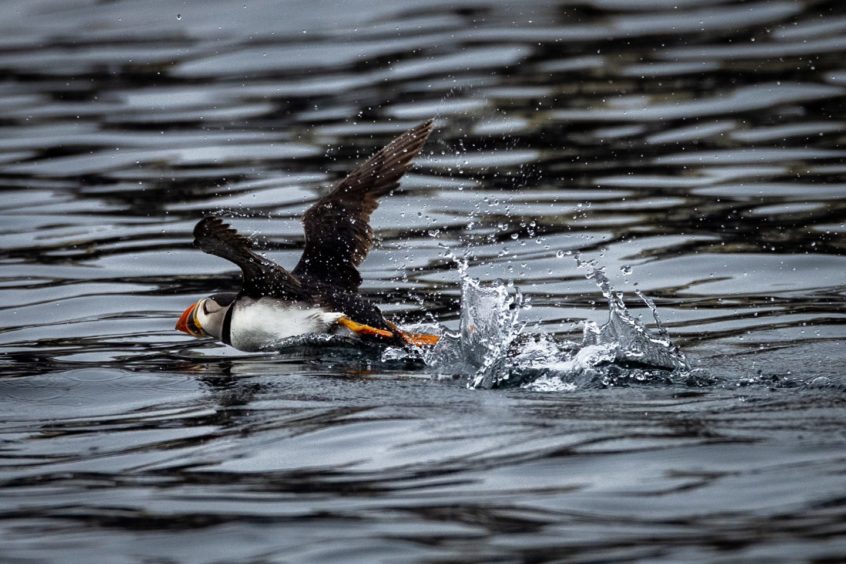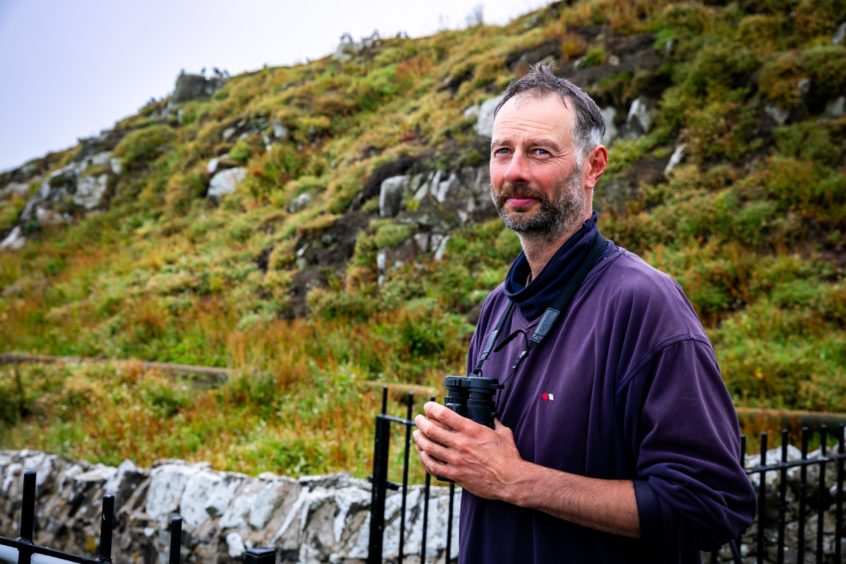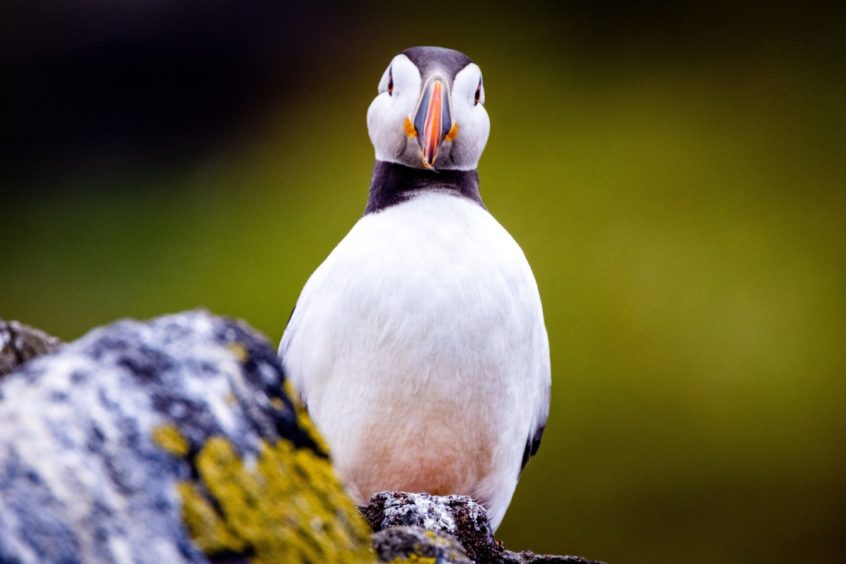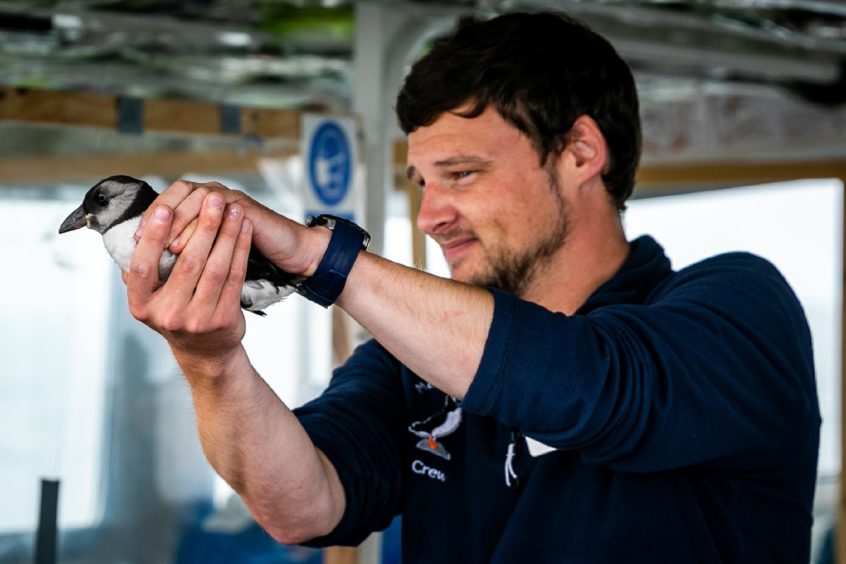Puffin populations are in trouble but experts on an island in the Forth are providing a refuge for the iconic clownlike seabird – for now.
Populations are declining elsewhere in Scotland.
However, the Isle of May’s 80,000 puffins are on track to enjoy their most successful breeding season since the millennium.
Helping conservation efforts is scientist Mark Newell.
“It looks like this year has been a very good season,” he said.
Mark has an unconventional job.
He is the island’s field manager and is employed by the UK Centre for Ecology and Hydrology (UKCEH), an independent, not-for-profit research institute.
Mark gathers vital data about the island’s various seabird species. This data informs decisions, for example, about offshore renewables projects which could have a negative impact on the birds’ survival chances.
His work involves spending three months of the year living on the island with a handful of other scientists and volunteers. And an estimated 200,000 noisy seabirds.
Puffin numbers slumped in 2008
The Isle of May’s puffins had a bad year in 2008. Warmer waters affected their main food source, sand eels, and many breeding pairs failed to raise pufflins – the name for puffin chicks.
“It was a couple of years of much warmer sea temperatures, particularly in winter, which is when the sand eels are spawning and growing,” he said.
“If you get warm sea temperatures around then, you tend to get far fewer sand eels. Or the sand eels will grow at a much slower rate.
“So therefore, most of the seabirds’ main food source is much depleted when it comes round to the breeding season.
“It was a combination of poor breeding season, with very few chicks reared, and also poor adult survival.”
What makes the Isle of May special?
But since then puffin numbers on the Isle of May have stabilised.
In contrast, they have struggled elsewhere.
Mark says one explanation is the Isle of May’s location protects the surrounding waters from the warming effects of the North Atlantic Drift.
“The waters here seem to be slightly more buffered from these consistently warmer sea events,” he said.
“It’s been much more of an issue off the west coast of Scotland, and even the north, and even into Scandinavia. They’ve been having a series of really poor years.
“It’s not reaching down into these parts of the North Sea – yet.
“It’s the largest east coast colony for puffins and is significant for a lot of other species as well.
“To have that of late doing consistently well does mean it’s a major refuge for them. Certainly down the east coast, and more broadly in a Scottish sense.”
Pufflin patrol
Mark and his UKCEH colleagues team up with staff from NatureScot, which manages the island, and crew members from the Isle of May ferry services to give young puffins the best chance of survival.
Gulls can easily pick off pufflins to feed their own chicks.
To avoid the gulls, pufflins sneak out at night and make their way to the open sea.
The tough little seabirds will spend the next five or six years at sea before returning to dry land to breed for the first time.

But they can lose their way.
“One small scale conservation effort that’s carried out here is the morning pufflin patrol,” said Mark.
“The pufflins leave burrows at night and make their way to sea.
“They’re totally independent at that point. The adults don’t even know they’re going.
“Because of the structure of the island with all these buildings and old walls, and some of the nettle beds, they get stuck. They don’t make it to the sea.
“We know where some of these key sticking points are. Between us and the NatureScot staff and volunteers, we go round and do a patrol every morning and find these stranded pufflins.”
Crew members on the May Princess regularly help out by bringing rescued pufflins on board their tourist trips and letting them go once they are safely away from the island, and hungry gull beaks.
‘Lethal’ nettles
One rather surprising problem for the Isle of May’s puffin population is the local nettles.
Birds can be effectively paralysed if they get their feet stung by the plants.
“The nettles on here are just lethal,” said Mark.
“Their feet actually get paralysed. We stick them in a box for a few hours and hope the toxins go out.”
He added: “It’s very much maintaining what’s here. The conservation efforts are more small scale.
“You’ve got visitors coming here. It’s hopefully providing some kind of educational element. Also, making sure they stick to the paths and things like that so there’s not a negative impact.”


